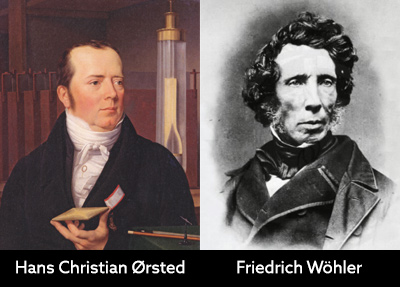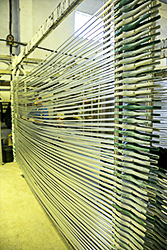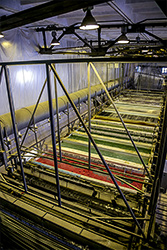Growing up, the idea of crushing a can of soda was ridiculous. To an 11 year old, trying to wrap my small hands around a can with enough strength to even make a dent became an accomplishment.
I know, right now you're looking at that aluminum can of pop wondering what in the world is this guy talking about? Back in my day, people were tougher because their cans were tougher! Today's aluminum can was yesterday's steel can.
Galvanic corrosion is one of the most challenging issues that engineers across all industries deal with based on how they use the metal.
Known for its insulation capabilities, aluminum oxide helps protect the metal from the ravages of atmospheric elements. The oxide layer used is over a thousand times thicker compared to natural aluminum oxide, which offers next to no galvanic protection.
Anodizing is an excellent solution for most applications because of the adhesion offered. So it does not flake off like even the best paint would after a while. Using so-called hard anodizing protects the metal in instances of higher wear, the type of wear that paint could never withstand.
Quick History of Aluminum
 In the late 1700s, an unknown metal was thought to exist in alum, but there wasn’t a way for extracting it. Hans Christian Ørsted, a Danish chemist, first extracted a tiny amount of aluminum in 1825. A few years later, a German chemist, Friedrich Wöhler, came up with an alternative way of extraction and, 20 years later, produced large enough samples for scientific research.
In the late 1700s, an unknown metal was thought to exist in alum, but there wasn’t a way for extracting it. Hans Christian Ørsted, a Danish chemist, first extracted a tiny amount of aluminum in 1825. A few years later, a German chemist, Friedrich Wöhler, came up with an alternative way of extraction and, 20 years later, produced large enough samples for scientific research.
In the 1800s, scientists thought aluminum to be rarer and more precious than gold and silver. Ironically, aluminum is of the most abundant metal in the earth’s crust. Unlike gold or silver, there are no veins for miners to extract. Instead, aluminum needs the combination of other elements forming compounds. Two of the most common compounds are alum, such as potassium aluminum sulfate (KAl(SO4)2·12H2O) and aluminum oxide (Al2O3).
Because of increasing interest, increased production led to two significant developments in the 1880s.
The first was the invention of a new process for obtaining aluminum from aluminum oxide. Charles Martin Hall, an American chemist, and Paul L. T. Héroult, a French chemist, each invented this process independently in 1886. The second was the invention of a new process that could cheaply obtain aluminum oxide from bauxite. Bauxite is an ore that contains a large amount of aluminum hydroxide (Al2O3·3H2O), along with other compounds. Karl Joseph Bayer, an Austrian chemist, developed this process in 1888. The Hall-Héroult and Bayer processes are still used today to produce nearly all of the world’s aluminum.
With an easy way to extract aluminum from aluminum oxide and an easy way to extract large amounts of aluminum oxide from bauxite, the era of inexpensive aluminum had begun. In 1888, Hall formed the Pittsburgh Reduction Company, which is now known as the Aluminum Company of America, or Alcoa. When it opened, his company could produce about 25 kilograms of aluminum a day. By 1909, his company was producing about 41,000 kilograms of aluminum a day. As a result of this huge increase of supply, the price of aluminum fell rapidly to about $0.60 per kilogram.
As aluminum usage grew, protecting the metal became a priority. This priority is where the anodization process stepped forward. A seaplane used the first industrial scaled anodization process.
4 Anodizing Methods
Now there are primarily four types of anodizing used across 99% of industries:
- Hard
- Color
- Black
- Titanium
Using anodizing for changing the overall surface topography, and the crystal structure increases corrosion resistance, the essential type has to do with aluminum anodizing.
Aluminum Anodizing
 Aluminum anodizing uses an electrochemical process that increases the thickness of a naturally occurring, passive, and yet protective aluminum oxide film. Adding electricity and chemicals forming a transparent and hard aluminum surface creates the second hardest material on earth.
Aluminum anodizing uses an electrochemical process that increases the thickness of a naturally occurring, passive, and yet protective aluminum oxide film. Adding electricity and chemicals forming a transparent and hard aluminum surface creates the second hardest material on earth.
Without the use of anodizing, aluminum corrodes, becomes weak over time, and be unusable. However, once the metal is weather resistant and very hard, it lasts a very long time. Another metal that's often anodized is titanium with similar results.
Cleaning the aluminum is the first step, preparing the surface for the process. Treating metal with a bath creates varying degrees of shininess. Three methods uses bright dip, satin, and matte. Once the product is ready to be anodized, there are several coating methods, including hard coat, color anodizing, and sulfuric acid. The next step is to cover the metal with a sealant or some dye.
The anodizing process is doesn't take long, usually a few hours. However, that time results in a colorful and highly corrosive resistant metal. Setting the color makes it attractive in use across a myriad of products—from smartphone housings to home appliances.
The inorganic nature of anodized aluminum means that ultraviolet rays don't affect it. Stripping away the top anodized layer makes it possible for repair or re-color. Anodized surfaces eliminate flaking, which means they keep their color and shine for decades.
Standard Anodizing
 Standard anodizing creates an excellent base for organic coatings and other metals. Products using anodized metal include grills, mailboxes, dryers, refrigerators, pans, pots, wheel covers, and bicycle frames. The architectural industry primarily depends on these anodized metals for framing buildings.
Standard anodizing creates an excellent base for organic coatings and other metals. Products using anodized metal include grills, mailboxes, dryers, refrigerators, pans, pots, wheel covers, and bicycle frames. The architectural industry primarily depends on these anodized metals for framing buildings.
A few other industries benefiting from anodized metal include the automotive industry, aerospace, and medical.
Anodizing Processes
There are four primary anodizing processes for aluminum.
Chromic Acid
These anodic coatings form within chromatic acid and are comparatively thin. They usually measure around 0.1-0.3 mil. However, they remain corrosion resistant.
The defense and aircraft industries use chromatic acid. The earliest use of this process was with seaplanes back in the 1920s. Since chromatic acid is carcinogenic, developing alternatives eliminating the hazard has been a priority.
Sulfuric Acid
Sulfuric acid anodizing is the most widely used process. The thickness of the coating varies from 0.1 to 1.0 mil, which depends on the application.
Creating many different colors becomes possible using the sulfuric acid anodizing process. Varying the immersion time from 10 to 30 minutes affects the depth and intensity of the color.
Hard Coat
Among the many methods used for anodizing aluminum, hard coat is the most useful. It forms a non-conductive film and has better wear resistance.
The major difference of the a hard coat anodizing process is using sulfuric acid, forming the hard coat ranging from 1 to 5 mils. The process is like regular anodizing but doesn't require brightening the metal.
Concentrated sulfuric acid is used for one method. Low-temperature hard coating uses concentrated sulfuric acid. Applying current for a set amount of time creates and density achieves the needed thickness. For some applications, they use unique waveforms plus alternate or pulse current.
Phosphoric Acid
Phosphoric acid anodization works by producing a thin film, measuring 0.1-0.2 mil. This type of film is useful for preparing lithographic printing plates and for bonding aircraft components.
In Sum
Anodizing is one of the best ways of ensuring that the metal lasts a long time, looks great, and hardened against regular wear. Anodizing adds at least a decade of service life to most components, if not more.
The anodizing process has been used for over a century. During this time, methods have developed nearly perfecting the finish. The finishing and overall hardening make it ideally suited to a variety of industries. It is cheaper, offering a higher return on investment than paint or any other form of protection.